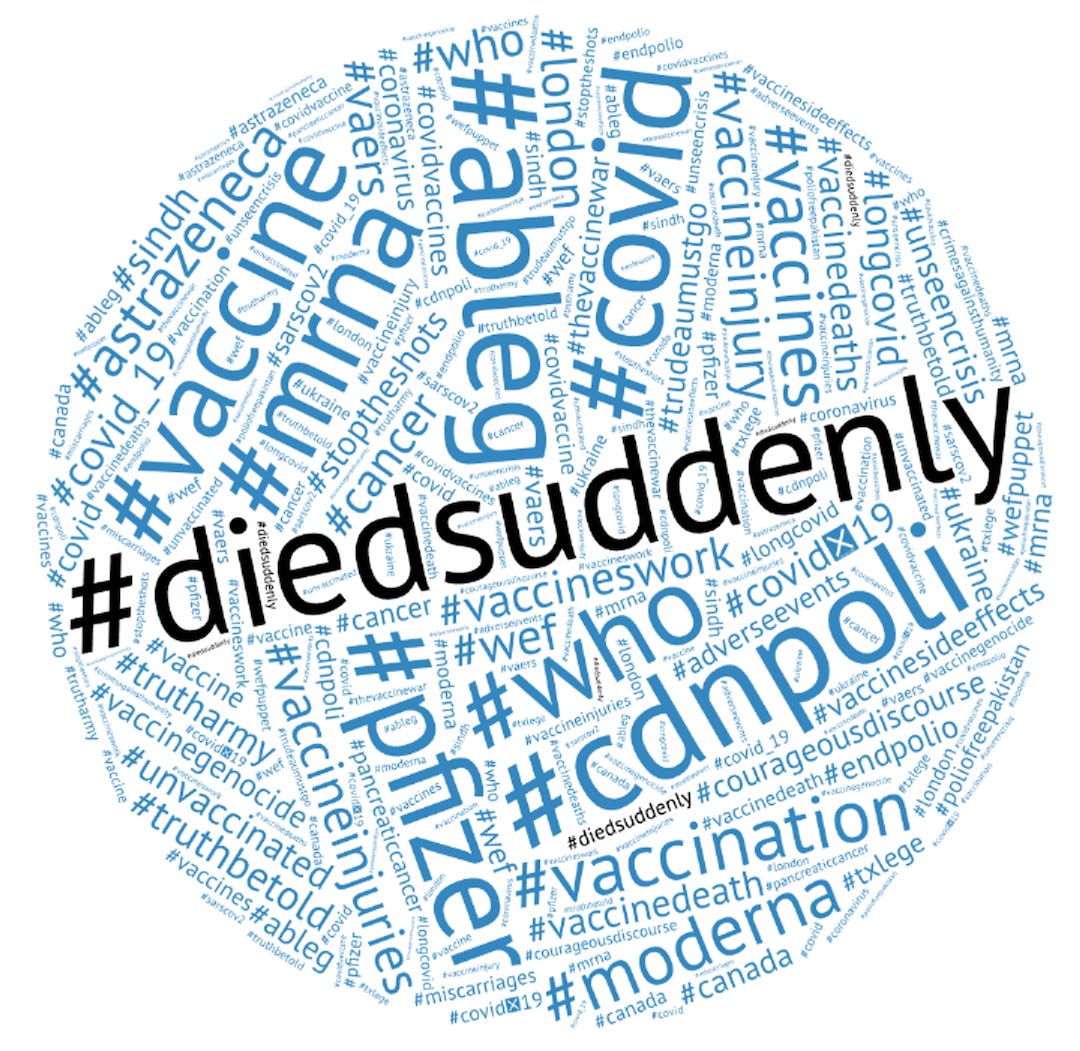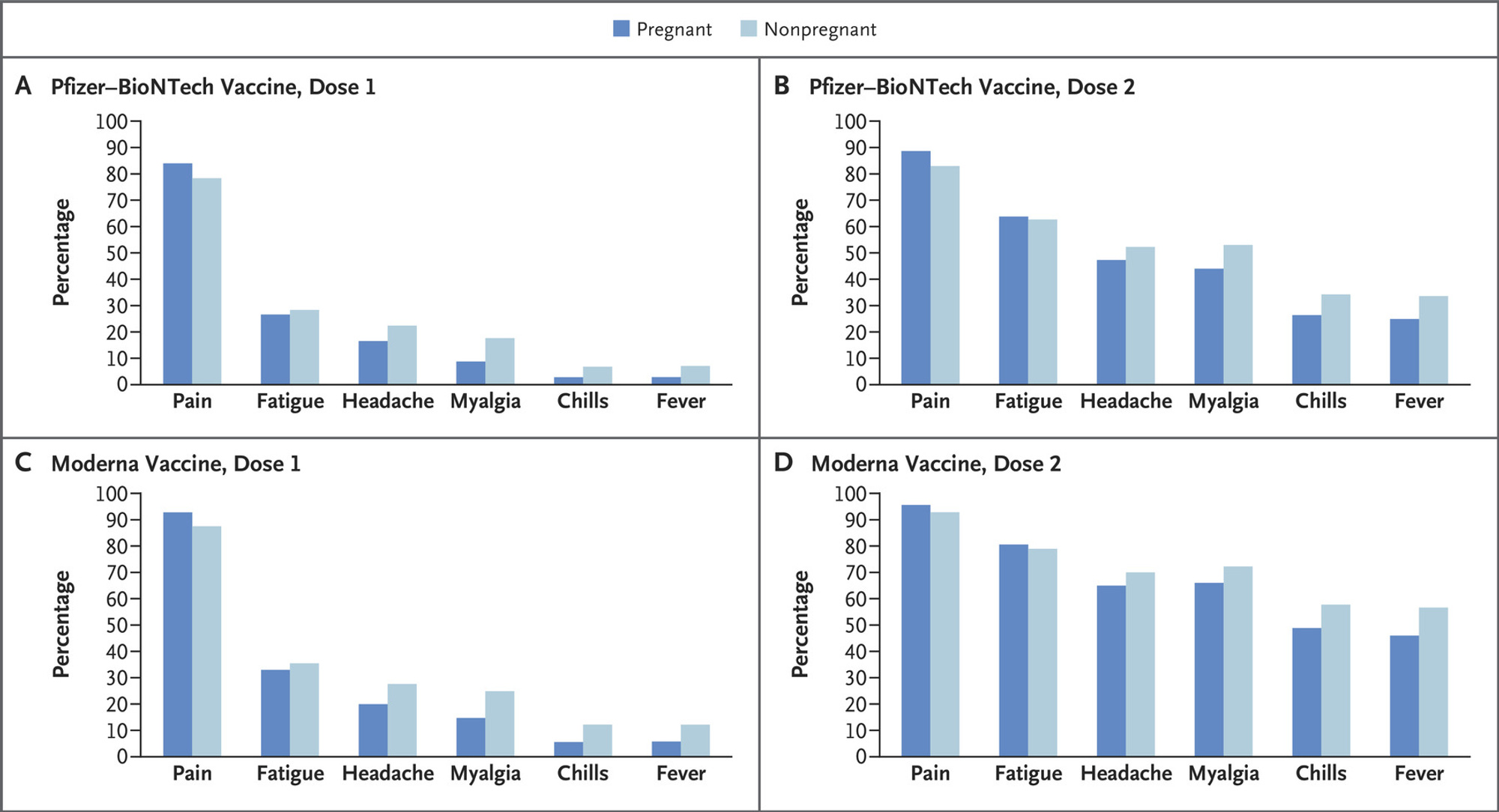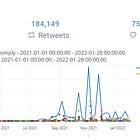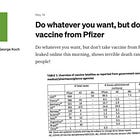Infodemic Report: Vaccines in May 2023
We discuss the hashtag that would not "die suddenly," spikes in tweets about vaccines and Canadian politics, and influential false or misleading claims.
The definitions and information about data sourcing can be found in the Appendix. Resources used for graphs are linked when referenced in the text. The findings in this analysis led us to draft an accompanying article: Ghouling, a trend of unspeakable cruelty.
A sharp surge in tweets about Canadian COVID policies
On May 12, there was a steep increase in the number of tweets about COVID-19 policies and politics. The tweets centered on Canadian policies. The graph shows the number of vaccine-related tweets from North America between May 11 and 17, 2023. The counts were sorted by language into Spanish and English. Most of the jump occurs in a 15-minute window.
See image citations and detail here: Vaccine-related tweets from North America from May 11 to 17.
After examining accounts that use hashtags related to Canada and vaccines, it appears that some of them might be fake. However, this doesn’t mean there isn’t real public support for the expressed ideas. The conversation about Canadian policies and politics might have been artificially amplified.
Another spike occurred on May 17. The surge appears tied to highly influential accounts making the same false claim about CDC directions to destroy expired vaccines. This was presented as CDC ordering them to be removed from the market and destroyed. This is incorrect. The vaccines are being destroyed because they expired, not because of harm.
Although there is a lot of crossover between English and Spanish-speaking mis- and disinformation, here, the posts in Spanish appear unchanged while the line for English-language tweets takes a near-90-degree turn skyward. The same was true earlier in the week with the Canadian policy tweets.
Top hashtags in vaccine-related tweets
The most popular hashtags from May 11 to 17, globally, from most popular to least, are as follows: #diedsuddenly, #cdnpoli, #ableg, #vaccine, #pfizer, #covid, #vaccineinjuries, #mrna, #vaccineinjury, #vaccines, #vaccinegenocide, #unvaccinated, #vaccination, #who, #moderna, #vaccinedeaths, #astrazeneca, #truthbetold, #longcovid, #vaccineswork, #unseencrisis, #courageousdiscourse, #vaccinesideeffects, #stoptheshots, #vaccinedeath, #covid_19, #poliofreepakistan, #trudeaumustgo, #london, #covidvaccines, #trutharmy, #cancer, #covidー19, #pancreaticcancer, #coronavirus, #crimesagainsthumanity, #covidvaccine, #endpolio, #wef, #vaers, #sindh, #canada, #ukraine, #sarscov2, #wefpuppet, #txlege, #thevaccinewar, #miscarriages, #adverseevents.
The second most popular hashtag from North America lagged behind the first by a significant degree. In North America alone, the most popular hashtag for the same time frame was #TrudeauMustGo. That was another Canada-themed hashtag, #cdnpoli (Canadian politics).
Hoaxlines has documented apparent inauthentic activity online related to Canadian truck protests. The 2021 case study examines what happened to accounts that were amplifying protest tweets. We found that some accounts had deleted the tweets shortly after and then deleted the account altogether. This is distinct from a user being suspended.
This tactic has been observed in Turkish Twitter and dubbed ephemeral tweeting.
For more on the global hashtag data, see Most popular hashtags from May 11 to 17. The hashtags can be broadly grouped into a few categories:
General vaccine-related hashtags include #vaccine, #covid, #vaccines, #vaccination, #covidvaccines, and #covidvaccine. These tags are often used in public discussions about vaccines or the COVID-19 vaccine.
Vaccine brand-related hashtags: Here, we see tags related to specific brands of vaccines, like #pfizer, #moderna, and #astrazeneca. These tags are likely used in conversations about experiences, news, or data specific to these vaccine brands.
Negative sentiment hashtags: These include tags such as #diedsuddenly, #vaccineinjuries, #vaccineinjury, #vaccinegenocide, #vaccinedeaths, #vaccinedeath, #stoptheshots, #vaccinesideeffects, and #adverseevents. These hashtags suggest much discussion around adverse outcomes or concerns related to vaccines.
Hashtags related to specific regions or politics: Tags like #cdnpoli (Canadian politics), #ableg (Alberta legislature), #london, #canada, #ukraine, and #txlege (Texas legislature) suggest geographic-specific conversations or issues related to vaccines. The tag #trudeaumustgo indicates some political dissatisfaction related to vaccine policies in Canada.
Other disease-related hashtags include #longcovid, #cancer, #poliofreepakistan, #endpolio, and #pancreaticcancer. These suggest conversations around other diseases in the context of vaccines or as standalone topics.
Miscellaneous hashtags: Tags like #unvaccinated, #who (World Health Organization), #truthbetold, #unseencrisis, #courageousdiscourse, #trutharmy, #wef (World Economic Forum), #wefpuppet, and #thevaccinewar fall into this category and may relate to various aspects of vaccine discussions, from policy to personal beliefs and conspiracy theories.
Top tweets about vaccines globally
Using a list of influencers on Twitter for “diedsuddenly,” obtained from BuzzSumo, Hoaxlines Lab finds that the set of 120 accounts has a combined follower count of 5,207,882.
Given that the reach of many of the viral tweets from the “diedsuddenly” community goes beyond people who do not follow them, the reach is substantial. This is also just one platform. Telegram, for example, also has related content and little moderation. Mr. Peters has repeatedly used the phrase as a coupon code on Telegram, where he urged people to invest in gold and silver over an IRA, one of the most reliable and fruitful investment options available to people in the United States.
Looking at the most popular recent tweets, negative sentiments prevailed. Many were controversial (conflict with the consensus of the most qualified parties) or contained false claims, as was the case with the “500% increase in HIV in the military”. Inaccurate and shocking content performs well on the platform, so while this result is not surprising, it is a good demonstration of that outcome.
See graph citations for more detail: Most popular tweets globally, between May 11 to 17, 2023, in English-language about vaccines.
There were some positive messages about vaccines, like the one from @jonathanstea, showing these can also reach a high level of engagement. To compete with more entertaining figures who may offer little credible information, science must learn to make the truth as engaging as possible because both platform algorithms and the human mind find the alternative much more attractive.
The discourse around vaccines on Twitter is multifaceted, ranging from general vaccine topics to specific concerns, political debates, and geographical issues. Significant conversation and engagement occur around negative perceptions and potential side effects or risks associated with vaccines. The engagement, especially if it is inauthentically boosted, may skew public perception of the risks and spread false or misleading claims that drive vaccine hesitancy.
Influential posts
For a more in-depth address of the consequences of COVID conspiracy theories, see Ghouling, a trend of unspeakable cruelty.
Other influential vaccine-related posts have been included in this section. They are not exhaustive but give an overarching idea of the types of narratives now.
One article that received over 17,000 shares on Twitter and over 800 on Facebook is called “100% of COVID Deaths in Canada Now Due to mRNA Vaccine, New Data Shows.”
This claim is false (Watson et al., 2022). One estimate from June 2022 found that in the first year of vaccination (from December 8, 2020, to December 8, 2021), the world should have expected around 18.1 million deaths without vaccines. About 14.4 million of those were prevented.
This means that vaccines may have reduced the global death rate by 79% during the first year of vaccinations. However, these numbers may be lower than the actual number of lives saved because the study did not consider deaths caused by COVID-19 that were not reported as such.
Elon Musk tweeted that U.S. President Biden tried to fire “some of our best people” for being unvaccinated.
This was the single most engaged vaccine-related tweet globally for the week of May 11 to 17, 2023.
Candace Owens shared a personal story on TikTok about receiving the Gardasil vaccine. Owens also promoted the story on Twitter.
While one cannot argue with her experience, she has a history of false, misleading, or exaggerated claims and has no relevant experience or scholarship related to vaccines.
Candace Owens falsely claimed in 2021 that “The CDC actually put together a document to discuss putting high risk people into camps to ‘shield’ low risk people from them.”
In 2020 Owens posted, “Everyone is only dying of coronavirus now.” This was false. There were many coronavirus deaths and increases from other causes, suggesting we were undercounting deaths.
The Daily Wire, her employer, has previously used anti-vaccine hashtags in marketing campaigns, as documented by Hoaxlines Lab in 2021.
Joseph Mercola published an article on Children’s Health Defense called “How Big Pharma Controls Scientific Research,” promoting a popular trope that casts scientists as beholden to pharmaceutical companies.
Prebunking Health Misinformation Tropes Can Stop Their Spread
Medical conspiracy theories: cognitive science and implications for ethics
Conspiracy theories have always been present, but recent trends in politics and media make it appear that they are on the rise. This is also true for medical conspiracy theories. This article reviews some of the most notorious health-related conspiracy theories and explains why people believe them using concepts from cognitive science.
Based on this knowledge, the article presents normative proposals for public health officials and health workers to deal with conspiracy theories while preserving fundamental principles of medical ethics.
Steve Kirsch (@stkirsch) claimed that vaccines are causing “eyeball clots.”
The claim is based on the findings of a study in Nature. The study calls for further research and suggests the relationship may not be coincidental. This is far from certain, and as the study notes, “the causality between the two is debatable.”
Over 150,000 people have seen a post reiterating an older false claim about Bill Gates and a vaccine trial in India.
A 2021 list from Hoaxlines Lab gathered state-sponsored Bill Gates conspiracy theories from a database of disinformation. It’s pretty remarkable just how many there are.
Here’s a primer on the limits of state power and public health from 2020: Do State Public Health Orders Conflict with the Constitution?
The Rumor Mill
Expired J&J vaccines are being destroyed, not “pulled”
To put it simply, the issue is not that something terrible happened. Instead, many J&J vaccines (about 12.5 million doses) were unused. Unless someone feels that it was terrible that the vaccines expired (some people certainly do), nothing happened here. Still, influential posts on social media have implied otherwise.
Since its introduction, approximately 19 million individuals in the United States have received the Johnson & Johnson (J&J) vaccine. Despite the distribution of over 31.5 million doses across various states and jurisdictions, approximately 12.5 million doses remain unused, according to data from the Centers for Disease Control and Prevention (CDC).
Last year, the CDC restricted the emergency use authorization of the J&J vaccine to adults for whom other vaccines were not suitable or accessible. This was due to the potential risk of a rare but severe clotting disorder known as thrombosis with thrombocytopenia syndrome that could develop post-vaccine.
The J&J vaccines expired on May 7, 2023, so the CDC instructed that any remaining doses be destroyed.
False claims about vaccines and HIV in the military
A tweet claiming that the U.S. military is now broadly testing soldiers for “AIDS” (we test for HIV, not AIDS) racked up over 2700 retweets in a few hours on May 17, 2023. The same claim went viral in March when Stew Peters, a prominent conspiracy theorist, tweeted about it.
Claims that the U.S. military has seen a 500% increase in HIV cases after the COVID-19 vaccinations are unfounded.
Official figures show a slight rise in HIV diagnoses from 237 in 2020 to 309 in 2021 (a 30% increase), followed by a drop to 124 in 2022.
This decrease represents a nearly 60% drop from 2021. There’s no evidence linking the COVID-19 vaccine to the development of HIV.
These claims, spread by conservative influencers, notably radio host Hal Turner, are unsupported by any data or evidence. Turner did not respond to requests for comment from AP.
The Defense Department and the Congressional Research Service have confirmed that these figures are greatly exaggerated. They also reiterated that no condition known as “vaccine acquired immunodeficiency syndrome” or “VAIDS” exists. The idea appeared online in 2021 among accounts known for spreading unsubstantiated claims.
In the last six years, the average number of new HIV cases in the U.S. military has been about 264 per year, consistent with earlier estimates. These numbers include service members in the National Guard and Reserves.
Misinformation concerning increased rates of various illnesses following the COVID-19 vaccination among military personnel has been spread before, citing “leaked” data from the Defense Medical Epidemiology Database (DMED).
The Defense Health Agency revealed that this data was flawed due to an error for 2016 to 2020, causing an illusion of a disproportionate increase in medical conditions in 2021. This issue has since been corrected.
Source: AP News; Reuters; USAToday; Lead Stories
False or misleading claims about vaccinating livestock
Misleading claims about mRNA vaccines and livestock have been recirculating. Social media posts allege that farmers must vaccinate their cattle using mRNA vaccines, which are currently not licensed.
Some claims also falsely suggest that humans who consume animals vaccinated with mRNA will consume the mRNA themselves. Comments made by Bill Gates about his foundation’s funding for livestock vaccine development likely play a role in its reappearance. The Texas Department of Agriculture’s press release urging caution related to this specific technology may also contribute to concerns. Sources: Health Feedback, AP News
Are there livestock vaccines with mRNA technology?
No vaccine for livestock in the US uses the same mRNA tech as the COVID-19 vaccine. Some livestock received a COVID-19 immunization but did not use mRNA tech.
RNA tech is used in vaccines for swine, such as Merck’s Sequivity vaccine. Merck’s tech predates and differs from the mRNA tech used in the COVID-19 vaccine. Sources: Health Feedback, AP News
What does the U.S. government require for livestock vaccinations?
According to Marissa Perry, a spokesperson for the US Department of Agriculture, business owners are not required to vaccinate their livestock. The decision is left up to individuals.
Some agricultural workers choose to vaccinate their livestock, as it has been proven safe and effective in preventing disease. Source: AP News
Can vaccinating animals harm human health?
Consuming animal products from vaccinated livestock does not harm human health. Vaccine withdrawal periods ensure that the animal products humans consume are free from vaccine remnants. Source: APHIS
mRNA vaccines for animals are in early phases and may protect against diseases that regular vaccines cannot. That doesn’t mean it will end up in your food.
Concerns about “vaccinating” people through food are unfounded, although they touch on existing technology. Additionally, everyone alive already has mRNA in their body. Its application is for diseases threatening humans in wild animals that we could not efficiently vaccinate.
The most well-known example is the self-spreading vaccine for use in foxes. This technology is not designed to fool or violate the rights of humans and has already been implemented in thirteen U.S. states.
What is Bill Gates’ involvement in this?
A video of Bill Gates discussing the Gates Foundation’s partnership with the UK Department for International Development to promote livestock vaccination has been shared on social media.
Conspiracy theorists have claimed that Gates aims to use mRNA tech as a depopulation tool. However, there is no evidence that Gates or other global elites use vaccinations to control the population or negatively impact the food supply. Sources: Reuters, Reuters
In 2021, Hoaxlines Lab compiled a list of Bill Gates conspiracy theories exclusively sourced from foreign states. It’s quite a list!
Other Rumors
German study looked into COVID’s impact on the brain, not vaccine effects
The debunk from AP News explains it succinctly:
Social media posts are circulating a headline that misrepresents a study exploring the ramifications of COVID-19 on the brain, falsely suggesting the research was centered on vaccines. The “European Study Concludes COVID Jabs Cause ‘Long-Term Brain Damage,’” reads the headline from The People’s Voice, a website that has spread misinformation and previously operated as News Punch and Your News Wire. The story was shared by thousands on Twitter, and the headline appeared in screenshots on Instagram.
Covid vaccines are not linked to excess deaths, despite what the anti-vaxxers believe.
Joseph Mercola published an article on Children’s Health Defense that falsely claims that vaccines were linked to a “27-fold higher risk of miscarriage.” The study cited was not peer-reviewed and was co-authored with other frequent CHD authors. The false or unsubstantiated claims in the article are repeated on Rumble in the video’s text description.
As Hoaxlines Lab covered in 2021:
Reports from over 35,000 US women who received mRNA vaccines while pregnant show comparable rates of miscarriage, premature birth, and other complications compared to before the pandemic. These preliminary results reflect women who received either the Moderna or Pfizer mRNA shots while pregnant. Their rates of miscarriage, premature births, and other complications were comparable to those observed in published reports on pregnant women before the pandemic.
Critically, we know that pregnant women are more likely to fall seriously ill if infected with Covid, and while we haven’t found the virus affecting babies in utero, it may affect them in ways that are harder to detect.
In 2022, JAMA published a summary of other studies of vaccinated pregnant women. The participants spanned countries and totaled 250,000. They found the vaccines were safe and there were no increased risks to pregnant women.
More studies demonstrating vaccination safety during pregnancy can be found in the appendix.
Also, see our 2021 article “What to know about COVID vaccines, fertility, and pregnancy,” which was reviewed by a licensed OB-GYN and published in Being Well.
Another article published on May 19 on Children’s Health Defense, “‘Sad Day for Babies and Mums’: FDA Panel Recommends Pfizer’s RSV Vaccine for Pregnant Women,” emphasizes potential risks and frames it as if this would not be discussed with pregnant women.
Data have repeatedly shown more vaccines = less death
A study published in JAMA in late 2022 assessed the excess deaths (deaths that exceed the number we would expect). During the Delta and Omicron waves of COVID-19, the United States reported 370,298 COVID-19 deaths, with a rate of 112 deaths per 100,000 people. This was significantly higher than the COVID-19 death rates in other peer countries.
States with higher vaccination rates within the US had significantly fewer COVID-19 deaths. The top 10 states with 73% vaccination coverage had a death rate of 75 deaths per 100,000, while the bottom ten states with 52% had 146 deaths per 100,000.
Excess all-cause mortality (deaths from any cause beyond the number we would expect) in the U.S. also exceeded the COVID-19 mortality rate.
The overall excess deaths from any cause in the US was 145 per 100,000, higher than other peer countries.
The ten most-vaccinated states had comparable or lower excess all-cause mortality rates compared to several peer countries, such as Denmark, Germany, the Netherlands, Austria, Italy, and Finland.
If the COVID-19 mortality rate in the US matched that of the ten most-vaccinated states, an estimated 122,304 deaths could have been averted between June 27, 2021, and March 26, 2022.
If the US had the same number of deaths as the ten most-vaccinated states, around 266,700 deaths could have been prevented. If the US had a death rate similar to peer countries, it might have avoided 154,622 to 357,899 deaths from COVID-19 or 209,924 to 465,747 deaths from any cause.
Indeed, many people have died suddenly, but the data show it’s unlikely to be because of the vaccine. On the contrary, places with the highest vaccination rates saw significantly lower death rates. Whatever anyone says, the proof is in the data.
Source: Bilinski A, Thompson K, Emanuel E. COVID-19 and Excess All-Cause Mortality in the US and 20 Comparison Countries, June 2021-March 2022. JAMA. 2023;329(1):92–94. doi:10.1001/jama.2022.21795


















